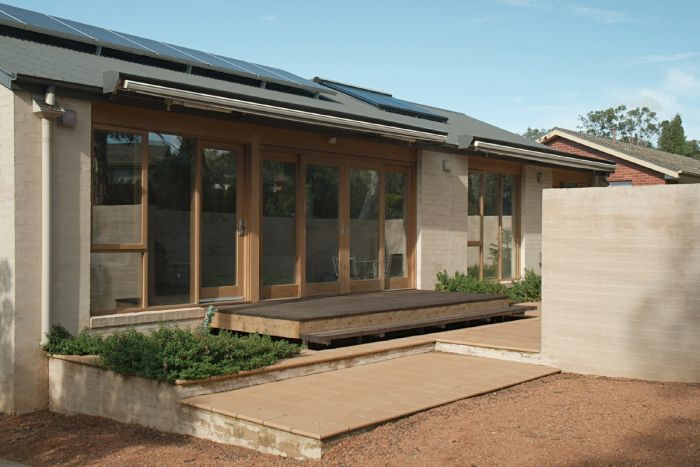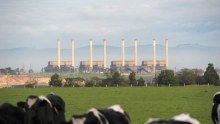Why does this ex-govie house appear throughout Canberra?
Updated
Trevor Hickman lives in a small brick house he's seen all over the city — a three-bedroom ex-government house that was built in the 1960s.
It's home to Trevor and his two children, Audrey and Eli, and the family of three live with some of its more unusual features every day.
"Ours has got a tiny, tiny bath... it's about two-foot long, so it's very strange," he said.
"It's almost like a caravan of houses."
Other aspects of the house have always puzzled him, from the crawl space beneath the building to its diagonal placement on the block.
It prompted him to ask: Who did the original design? How quickly were the houses built? And why were some of them raised up?
Canberra happens to be filled with different kinds of ex-government houses, which hints at how the city was designed, built and populated.
Two details helped me narrow down which house Trevor was asking about — his ex-govie was built in 1964, in the south Canberra suburb of Curtin.
It happens to be one of the most common, and smallest, ex-govies in the city.
The 400 series
"What you're looking at is a very economical, modest house... with three bedrooms, bathroom, toilet and large backyard," said Dianne Firth, a landscape architect and Deputy Chair of the ACT Heritage Council.
Dianne joined me at Trevor's house, where we looked at a series of plans I'd found on the ArchivesACT website.
They detail 16 different types of ex-govies that were built in the 1960's, known as the 400 series.
The number of bedrooms varied from two to four but the rectangular shape and layout of the houses remained the same.
"It's wonderful to see the different series," Trevor said. He quickly identified his home as a 405.
 Photo:
Dianne Firth from the University of Canberra and questioner Trevor Hickman look over house plans. (ABC News: Sonya Gee)
Photo:
Dianne Firth from the University of Canberra and questioner Trevor Hickman look over house plans. (ABC News: Sonya Gee)
Still, Trevor wondered why the houses were built in such large numbers — his suburb is full of them.
"It was in the '60s that Canberra was expanding by 10 or 12 per cent population every year and there was a huge demand for public housing," historian Alan Foskett said.
"The public service was expanding quite rapidly and people were coming into Canberra — like myself."
A housing review, completed in 1961, reveals more about the design and construction of the ex-govies.
The suburb of Downer was a test-site of sorts, 13 houses from the 400 series were built and critiqued before construction began in the city's inner north and in the first suburbs of Woden.
As to how quickly the houses were built, Dianne believes that whole suburbs would have been completed within two years.
Finding out who designed the houses was harder to pin down.
"They were a series that had been designed within the Department of Works by the various architects that were in the department," architect Neil Renfree said.
Plain and simple
For Canberra's early residents, being assigned a government house was a rite of passage.
"That had been the way of getting housing since back in the '20s... you came to Canberra, you registered, you waited your time," Alan said.
Couples had some say in the house they were allocated but Alan says it often came down a family's size.
Trevor wondered whether your position in the public service also played a part.
"In the early days it did depend on where you worked, so there was social stratification," Dianne said.
"If you were prepared to come all the way out to Curtin, you would get a better house and you would probably be offered a choice."
Architect Philip Leeson lived in an ex-govie with his family in the '80s.
"These houses were really stripped back to the bare necessity," he said.
"The front door opened straight into the living room... they didn't have any cupboards built in apart from a fairly basic kitchen and one linen cupboard that was less than a metre wide."
The houses also lacked insulation, making them incredibly cold in winter and hot in summer.
 Photo:
Architects from the Public Works Department in 1966. A similar team would have designed the 400 series. (Supplied: National Archives of Australia)
Photo:
Architects from the Public Works Department in 1966. A similar team would have designed the 400 series. (Supplied: National Archives of Australia)
Unlike earlier government houses, this series was brick veneer instead of double brick and many of the internal walls were thin and filled with corrugated cardboard.
"This is the story of Canberra... this was affordable housing," Dianne said.
The houses may have been built on a budget but they were also inexpensive to rent and buy — at least in the first instance.
ArchivesACT has put the tenancy registers of some government houses online, so I looked up Trevor's house and discovered it was originally sold in 1969 for $9950.
Like many ex-govies, it was sold to the tenant, who had rented the property for just $8.95 a week.
Let's get back to one of the quirks of Trevor's house — the crawl space beneath it.
"Back then they didn't level the way that we do now," Dianne said.
"When you come to this part of Woden, you've got rolling terrain. So how can you build economically? [By] putting it on the flat... rather than split level (but) it does mean you have the space underneath."
By the mid 1970s private development was on the rise, bringing the construction of new government houses to an end.
The tiny houses today
 Photo:
Chris Nugent wanted to know about ex-govies too. He owns a three-bedroom home in Downer. (ABC News: Sonya Gee)
Photo:
Chris Nugent wanted to know about ex-govies too. He owns a three-bedroom home in Downer. (ABC News: Sonya Gee)
Trevor's often wondered why his house was set so far back from the street, creating a large front and back yard and a lot of mowing.
Dianne says it shows how much our lifestyles have changed.
"If you think back to the 1970s, people didn't do so many things inside," she said.
"People got out at the weekends, you would go for a drive and you did things outside and the kids played outside."
The placement of the small houses in the middle of their blocks also made them easier to renovate.
"My own house was added to or modified in five minor to major additions," architect Philip Leeson said.
"It had an addition at the front and at the end and at the back and on the top."
Candida Griffiths won an ACT Architecture Award in 2010 for her renovation of an ex-govie in Hughes.
The original home was split in two, with the bedrooms in a wider section of the house and the living spaces in a narrower part.
"All I did was change the footprint by bringing out the wall so it was all in alignment, which added about 25 per cent of the floor area to the original living room," she said.
 Photo:
The new ceiling is 1.1 metres higher than the previous one at its highest point. (Supplied: Candida Griffiths)
Photo:
The new ceiling is 1.1 metres higher than the previous one at its highest point. (Supplied: Candida Griffiths)
The architect also replaced the roof and created a raked ceiling, in place of a flat ceiling.
It's thought that hundreds of ex-govie houses from the '60s remain in Canberra, in the city's inner north and south.
While their current value lies in their location and land, Candida believes that the structures are worth saving.
"The word sustainability doesn't mean let's knock a house down and put it in the garbage bin and start all over again," she said.
"The actual original government house has integrity and that is a very high thing for any building to have."
After learning the history of his "humble ex-govie", our questioner Trevor was reflective.
"The kids love the house and we've been here for a few years but knowing about it — I'll think twice about my next bit of reno," he said.
More about our questioner:
Originally from the UK, Trevor Hickman moved to Canberra eight years ago with his wife Amy. They rented their ex-govie house before buying it in 2008.
Amy was diagnosed with advanced breast cancer and died in 2014.
"People have kind of jokingly gone — the house fits us because there's only three of us. Obviously I wish there were four of us."
Despite some renovations, the home is recognisably a 405 ex-govie — even the original front door remains.
Subscribe to the podcast on iTunes.
Topics: urban-development-and-planning, housing, canberra-2600, curtin-2605, act, downer-2602, hughes-2605
First posted














